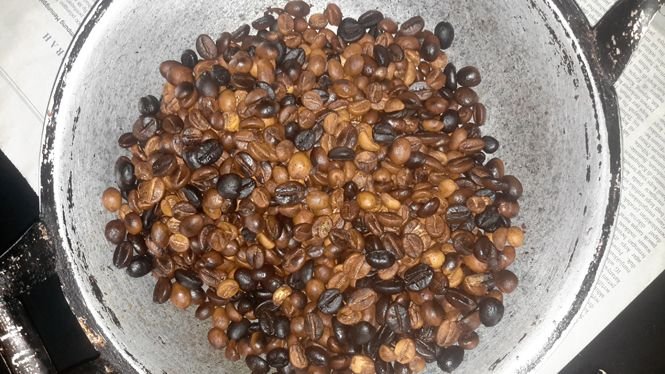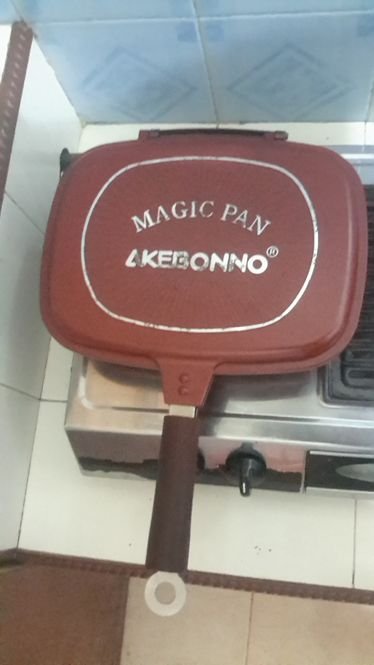
Living, as I do, in Java (itself a slang name for coffee) and just a short jump from Sumatera, home of one of the legendary coffees of the world, I decided it was high time to roast my own. I was also motivated by my deep and abiding hatred for Starbucks and those California cutsie chains that are not only taking over the world, but sell more political agendas than coffee.
My wife and I have decided to get into the business of selling raw, green coffee as part of our online empire. We have a plan to retire to our mountain retreat and spend our feeble years running a business on the internet while living well outside the madding crowd of over-dense cities.
We found several very good sources of raw coffee from Bali, Java and Sumatera, and we received enormous bags full of samples, ranging from mountain Robusta and Arabica beans, to the precious Kopi Luwak that sells for up to a few thousands dollars per kilo.
Having never done it before, I was a bit intimidated at the prospect of learning to roast coffee. What with all the mystique and legend built up around the little greenish-white beans, I figured this must be some occult ritual that required years of training and perfect alignment of the Heavens.
I was wrong.
If you've ever popped corn before, you can roast coffee. Yes, there are some timing issues and you have to pay close attention to the process, but you certainly don't have to be a magi to do it. There is a learning curve, but it is blissfully short and with a little practice, you can have the precise coffee you want every morning, fresher than anything you will EVER get from a store front, and the flavor of self-satisfaction is unmistakable and oh-so-sweet.

To roast coffee beans, I use a very high-tech and mystical device called a pan. It is vital to have a heat source, so I use an incredibly up-to-date propane stove. Turn the stove on to medium, throw a couple of handfuls of beans into the pan, shake it around for about 5 minutes, and POOF!
OK, it's a little more delicate than that, but not much.
First, DO NOT use oil or water, just beans. Second, anything that can make popcorn can roast coffee. If you use one of those hot-air poppers, though, remember that the fan noise can mask the "crack" sound, the importance of which will become apparent in a moment.
There are two important events during the roasting process that are vital to the outcome:
First Crack: at around the 3-5 minute mark, you will hear the distinct sound of the beans popping, just like popcorn. Again like popcorn, it will start with one or two pops, and then pick up speed. This is a critical moment. For lighter roasts, you will stop when the cracking stops. If you want darker roasts, you will go a few SECONDS to 1 MINUTE longer, until...
Second Crack: this time, it's not so much of a "pop" noise as as "sizzle" noise. If you go this far, stop immediately or you will be drinking charcoal water for breakfast.
Anything past the light roast phase is somewhat of an art form. Knowing precisely when to stop to get the exact level of roast you want is a trial-and-error process. Because each reader will use different equipment, live at different altitudes, et cetera, you will want to get a "feel" for how much longer past First Crack you want to go.
Lighter roasts give you a "smoother" flavor because the beans retain more of their natural sugars and starches, making the result a bit more naturally sweeter. This is the point of peak caffeine, as well, which for some of us is a major concern.
Darker roasts take on a more "full bodied" flavor, but also get increasingly bitter. They also get oilier, which some folks don't like.
Back to the process.
Once you decide to stop the roast, you will need to get the beans out of the heat and onto a cooling surface. This can be a cookie sheet, spread-out newspaper, or a wok like the one I use. The point is to cool the beans quickly by maximizing the airflow around them.
I suggest doing this outside, as the roasting process causes an ash-like chaff to burn off the beans. Coffee beans, like peanuts, have a skin on them that turns to burn-paper like ash when cooked. Rolling them around on the cooling surface and lightly blowing will remove the chaff and aid in cooling.
You're not quite ready to grind, though. The roasted beans will out-gas CO2 for up to 24 hours after roasting, and it's important to get rid of the gas for the best result. After cooling, I usually put the beans in a Tupperware container with an air-tight seal, but don't snap it all the way shut overnight. That will allow the gas to escape while retaining as much of the essential oils as possible, giving you the best results.
When I'm ready to use the roasted beans, I take only as much as I need, leaving the rest whole. You may not care, but I figure this preserves the essential oils and flavor better over time.
One note here: if you are roasting coffee because you think it will fill your house with the mouth-watering smell of fresh coffee, forget it. The smell is more like burnt sugar or chocolate, and it can be rather smoky and unpleasant in unventilated spaces. I like the smell, but it is entirely an individual thing. About an hour after you cool the beans, the familiar coffee aroma will start wafting through your humble abode.
That's it! You are now an amateur coffee roaster. With experience, you could rise to the level of Master and speak in mystical tones about the occult aspects and techniques that you have acquired. You could even get into the art of blending beans and roasts to get that Ultimate Cuppa Java. Until you get the hang of it, though, I wouldn't jump right into the Kopi Luwak that you just paid US$300/pound for.
In the past few years, there's been a green coffee fad with all sorts of magical health claims made about it. Personally, I think if it were that healthy, it wouldn't have taken several thousand years to figure it out, but that's up to you. Additionally, I don't particularly like the flavor, but again, that's entirely up to you.
My wife prepares it by taking the whole green beans, putting them in a glass container, and adding warm - but not hot or boiling - water. You must then let it set as least 24 hours and strain the liquid into a glass. She tries to get me to drink a glass of it every day for the anti-oxidants and other health y stuff, but I am hard-pressed to do so when I have piles of glorious hand-roasted beans just waiting for my loving attention.
Depending on your needs or tastes, having a supply of green coffee beans on hand can provide hours of palette-stirring excitement, both for the rich flavors and from the satisfaction of knowing you are far more talented than any Starbucks barista, and don't need fanciful foreign titles to make the job appear to justify the bloated prices.
If you want this glorious feeling of achievement every morning to start your day, then contact us at Radio Far Side (luap.jkt@gmail.com use Subject "Coffee") to get prices and shipping times for some of the most sought-after beans in the world, delivered directly to your door from Indonesia.
Soon, you will be serving premium, hand-roasted coffee to your guests at Maxwell House prices, and blowing them away with flavor, aroma and delicacy. Imagine the story you can tell them when they invariably ask, "Where did you get this coffee?"
Keep an eye on our D-Tube channel for a coming real-time (yes, it's that fast) how-to video for roasting your own coffee.
Superb intro post about the super complicated process and magic touch value add ons that the SJW Coffee Chains bestow on their coffees in order to charge us, maybe not an arm and a leg, but at least a pinkie for the privilege of sampling their coffee god creations. Now all we need is a comprehensive table of bean mixes / raw materials, Process Flow - Coffee results recipe guide, process control fine tuning and equipment usage model, and process stage attributes tweaking best known methods, and maybe, just maybe, we can unplug from the tyranny of those corporate clowns. If all goes well for your venture, *bucks would feel the (roasting) heat all right, and we the people will be free. Oh, i wish it so....
The roasting is remarkably easy - literally just like making popcorn. The entire process takes no more than 5 minutes. As for blends, that's part of the fun. I roast a little Arrabica and Robusta from different locations, each with different characteristics - then grind to a fine powder and mix them in different proportions and roasts (e.g. dark roasted Robusta with brown roasted Arrabica mixing Bali and Sumatera). Try using chocolate milk instead of regular. Use brown sugar instead of white. Use Bailey's Irish Cream for a little kick. Top with whipped cream. Add a dash of cinemon, nutmeg or vanilla extract. With a few simple ingredients and a total investment of about half an hour, you can have all sorts of exotic coffee and never even have to say the word "starclucks". Cost per cup is on the order of pennies.
At this very moment, I am enjoying a cup of Lake Toba (Sumatera) Arabica medium roast that I put up yesterday. I used a standard food processor to grind the beans and a French press to brew. The aroma is ecstatic and the texture is silky smooth with almost no bitterness. I allowed the coffee to steep for a little over 5 minutes before serving. Even my wife, who is not an aficionado, remarked on the flavor and aroma. Total time from raw bean to finished cup was about 15 minutes, allowing 24 hours between roasting and brewing for out-gassing.